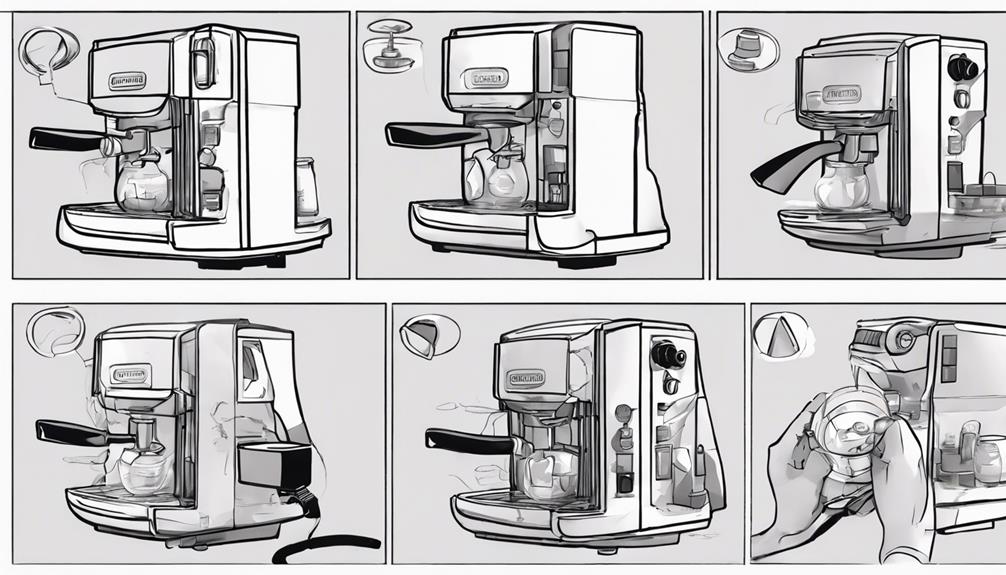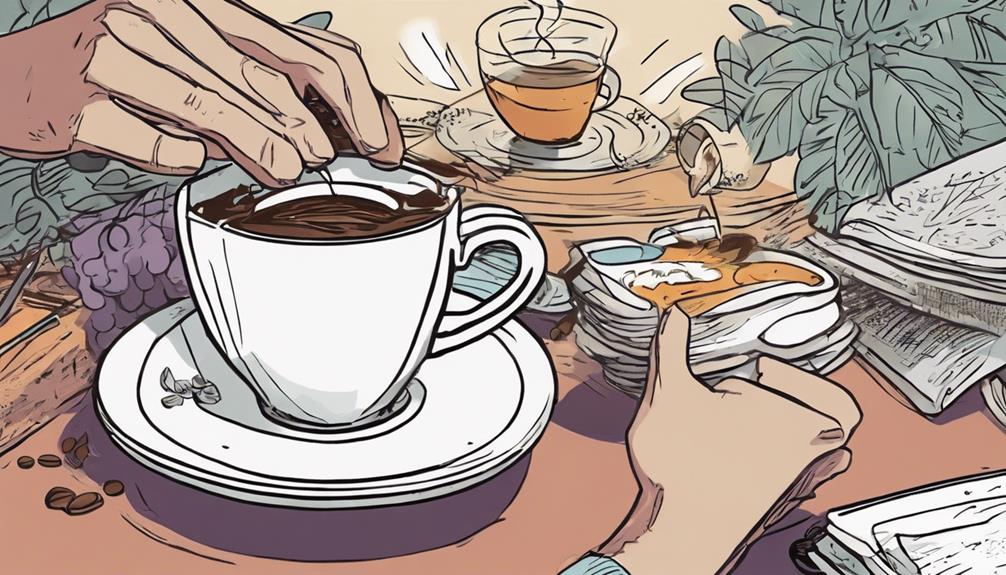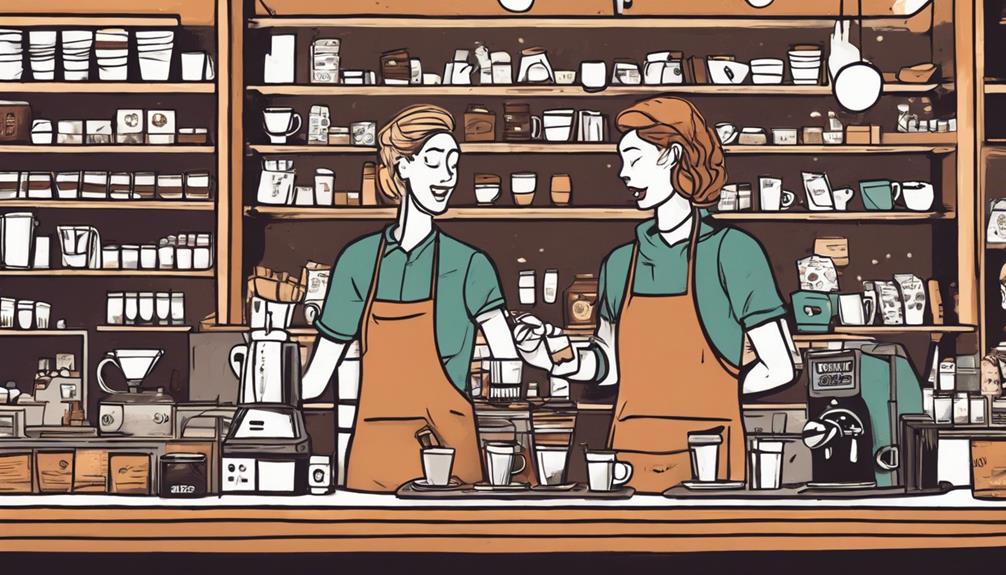To build a successful coffee brand, you must know the market, consumer trends, and provide ethically sourced, flavorful beans with a unique touch. Show your core values in branding, design logos well, and stay consistent. Utilize SEO, social media, and partnerships for effective marketing. Implement sustainability, follow trends like storytelling, and boost customer interaction for loyalty. Consider profitability with market research, pricing tactics, and online shopping trends. Don’t forget, a solid business plan, niche focus, and operational details are key. Master these aspects, and you’re on the path to crafting a booming coffee brand!
Key Takeaways
- Conduct thorough market research to understand trends and consumer preferences.
- Differentiate through niche targeting to attract the right customer base.
- Develop a solid business plan with marketing strategies and financial projections.
- Utilize operational logistics for effective brand growth and sustainability.
- Access resources for insights on starting a coffee brand with limited resources.
Getting Started in Coffee Branding
To begin your journey in coffee branding, start by researching and understanding the dynamics of the coffee market. Starting in the coffee industry requires a thorough exploration into consumer preferences and market trends. Consider the unique aspects that set your brand apart, such as offering ethically sourced beans or emphasizing sustainability practices.
Quality is key in this competitive market, where consumers are willing to pay a premium for exceptional products. Ensuring that your coffee stands out for its superior taste and consistency will help build a loyal customer base.
When starting your coffee brand, focus on providing a unique experience that resonates with your target audience. Whether it's through innovative brewing methods, distinctive flavor profiles, or a commitment to quality, find ways to differentiate your brand in a crowded market.
Crafting Your Brand Identity

Craft your brand identity by reflecting your core values and resonating with your target audience. Your brand identity is the essence of your brand, encompassing what you stand for and how you wish to be perceived by consumers.
When crafting your brand identity, make sure that it aligns closely with your core values, such as quality, sustainability, and passion for coffee. This alignment will help create a genuine connection with your target audience, fostering trust and loyalty.
Design logos and packaging that not only visually stand out but also communicate your brand's message effectively. Emphasize ethics, sustainability, and transparency in your branding to attract socially conscious consumers who value these principles. Your brand identity should reflect your dedication to providing high-quality coffee products and exceptional customer experiences.
Consistency is key in brand identity. Make sure that your branding is coherent across all platforms, from physical packaging to online presence. This consistency will help establish a strong and recognizable brand presence, making it easier for customers to identify and connect with your brand.
Marketing Your Coffee Brand

When marketing your coffee brand, leverage SEO, social media, and online ads to effectively promote your products.
Utilize digital marketing strategies to enhance brand visibility and reach a wider audience.
Hosting virtual coffee tasting events and collaborating with influencers can significantly boost engagement with your brand.
Providing high-quality content tailored to your target audience will attract and retain customers interested in your coffee offerings.
To secure the growth and success of your brand, passion, strategic planning, innovation, and customer engagement are paramount.
A well-thought-out marketing strategy is essential for establishing a strong presence in the competitive coffee market.
By carefully planning your digital marketing efforts and staying true to your brand identity, you can create a compelling narrative that resonates with consumers.
Sustainable Practices in Branding

Consider incorporating sustainable practices in your coffee branding to align with consumer preferences for eco-conscious products and make a positive impact on the environment.
Opting for eco-friendly packaging not only reduces waste but also appeals to environmentally aware consumers.
By establishing direct trade practices, you guarantee fair compensation for coffee farmers and promote sustainability within the industry.
Reducing your carbon footprint through energy initiatives showcases your dedication to environmental responsibility.
Supporting coffee-growing communities through various initiatives can positively influence your brand reputation and foster consumer loyalty.
It's vital to communicate these sustainability efforts to your customers to build trust and distinguish your brand in the competitive market.
Embracing sustainable practices like eco-friendly packaging and direct trade practices not only benefits the environment and communities but also enhances your brand's image and attractiveness to a growing segment of eco-conscious consumers.
Trends in Coffee Branding

You should consider incorporating storytelling into your branding strategy to forge emotional connections with your customers.
Additionally, creating limited edition releases can help generate excitement and foster a sense of exclusivity among coffee enthusiasts.
These trends can enhance your brand's appeal and cultivate a loyal customer base.
Storytelling in Branding
Storytelling plays an essential role in modern coffee branding, fostering emotional connections with consumers and setting brands apart in a competitive market. By weaving narratives that resonate with their target audience, coffee brands can establish strong emotional bonds that lead to lasting brand loyalty. These personal stories not only highlight the origin and values behind the coffee but also create a sense of authenticity and relatability that consumers crave in today's market.
Successful coffee brands leverage storytelling to engage customers on a deeper level, capturing their attention and loyalty through compelling brand narratives. Whether it's showcasing the journey of the beans from farm to cup or sharing the passion and dedication of the roasters, these stories humanize the brand and create a connection that goes beyond just the product itself.
In a crowded industry where differentiation is key, storytelling emerges as a powerful tool for coffee brands to carve out a unique identity, resonate with consumers, and ultimately build a loyal customer base.
Limited Edition Releases
Exclusive Edition Launches have become a prominent trend in modern coffee branding, creating excitement and driving sales through unique offerings and limited availability. Coffee brands leverage exclusive edition launches to showcase unique flavor profiles that captivate consumers, enticing them to try something new and exclusive. By introducing special packaging or novel blends, companies enhance their brand visibility and differentiate themselves in a crowded market.
These limited releases not only create a sense of urgency and exclusivity but also establish a connection with customers who value the opportunity to experience something out of the ordinary. The anticipation surrounding these exclusive editions fosters increased customer engagement and loyalty, as individuals eagerly await the next special release.
Customer Relationship Management

You should consider implementing loyalty programs to keep customers coming back for more of your coffee.
Personalizing your communication can make customers feel valued and understood, leading to stronger connections with your brand.
These strategies can help you build lasting relationships with your customers and create a loyal customer base.
Loyalty Programs
Utilizing loyalty programs is essential for cultivating strong customer relationships and fostering brand loyalty in the competitive coffee industry. Loyalty programs not only enhance customer retention but also provide valuable insights through customer feedback, enabling brands to tailor their offerings to meet preferences effectively.
To illustrate the significance of loyalty programs, consider the following benefits:
| Benefits of Loyalty Programs |
|---|
| 1. Improved Customer Retention |
| 2. Enhanced Customer Feedback Collection |
| 3. Personalized Offerings |
| 4. Increased Customer Satisfaction |
| 5. Community Engagement |
Personalized Communication
To strengthen customer relationships and foster brand loyalty, personalized communication plays a pivotal role in enhancing engagement and satisfaction within your coffee brand. By tailoring your messages and interactions based on customer preferences, you can greatly boost engagement and loyalty.
Implementing personalized communication strategies allows you to connect with your customers on a more personal level, showing them that you understand their needs and preferences.
Analyzing customer feedback is essential in this process, as it can lead to a 15% increase in customer satisfaction. By actively listening to your customers and adjusting your communication accordingly, you show that their opinions are valued, ultimately building a stronger bond with them.
Profitability in Coffee Sales

In the coffee industry, profitability in sales is an essential aspect that can determine the success and sustainability of a brand. Conducting thorough coffee market research is important for establishing a successful coffee brand. Understanding consumer preferences, market trends, and pricing strategies can help maximize profitability.
With the global coffee market projected to reach $690.09 billion by 2030, there's significant potential for growth and profitability in coffee sales.
Online shopping has become a key driver of profitability for coffee brands. The average consumer monthly order value for coffee products online is around $40, highlighting the lucrative nature of online coffee sales. Leveraging different business models such as coffee subscriptions and customizable bundles can further increase profitability.
Quality products and strategic marketing efforts play a crucial role in standing out in the competitive coffee industry and driving sales. Embracing online shopping opportunities can facilitate expansion and enhance profitability for your coffee brand.
Research and Planning for Success

Start by conducting thorough market research to lay a solid foundation for the success of your coffee brand. Understand current trends, competitors, and consumer preferences in the coffee industry through online resources and guides.
Familiarize yourself with the specific niche you want to target within the coffee market to effectively stand out. This niche targeting will help differentiate your brand and attract the right customer base.
In addition to market research, it's essential to develop a solid business plan before launching your coffee brand. Your business plan should outline strategies for success and growth, including marketing approaches, financial projections, and operational logistics. By having a clear roadmap in place, you can navigate the challenges of starting a coffee brand more effectively.
To further enhance your planning process, check out relevant blog posts and articles that offer valuable insights on starting a coffee brand with limited resources. These additional resources can provide practical tips and inspiration to help you shape your brand's identity and positioning in the competitive coffee market.
Frequently Asked Questions
How Can I Create My Own Brand of Coffee?
To create your own coffee brand, start by focusing on core products and gradually expand. Consider offering various coffee products, merchandise, and food items. Develop a solid business plan to guide your brand's growth and success.
How Much Does It Cost to Create Your Own Coffee Brand?
Creating your own coffee brand can cost between $100,000 to $600,000, covering permits, equipment, and initial inventory. Budget for future growth and operational costs like insurance and staff salaries to guarantee long-term financial sustainability.
Is a Coffee Brand Profitable?
Running a coffee brand can be profitable, with the global market set to hit $690.09 billion by 2030. By offering quality products and smart marketing, you can tap into the $40 average monthly order value per consumer for success.
What Makes a Good Coffee Brand?
Craft a good coffee brand by reflecting core values, designing standout logos, emphasizing quality and innovation, understanding consumer preferences, and leveraging digital marketing strategies. Engage customers with ethics, sustainability, transparency, and unique branding. Understanding consumer preferences is crucial in creating a successful coffee brand. By conducting market research and gathering feedback, we can tailor our product offerings to meet the needs and desires of our target audience. Whether it’s the convenience of single-serve pods or the rich flavor of whole bean coffee, we aim to provide options that cater to different preferences and lifestyles. In addition, leveraging digital marketing strategies will allow us to reach a wider audience and educate them on the benefits of making espresso at home. Through engaging content and targeted ads, we can showcase the quality and innovation behind our brand, ultimately converting more consumers into loyal coffee enthusiasts.
Conclusion
So, you've learned the ins and outs of building your own coffee brand. Now, all you have to do is sit back, relax, and watch the profits roll in, right? Wrong!
The coffee industry is competitive and constantly evolving, so don't get too comfortable. Keep innovating, connecting with your customers, and staying ahead of the trends to guarantee your brand's success.
Remember, in the world of coffee branding, the only constant is change.








